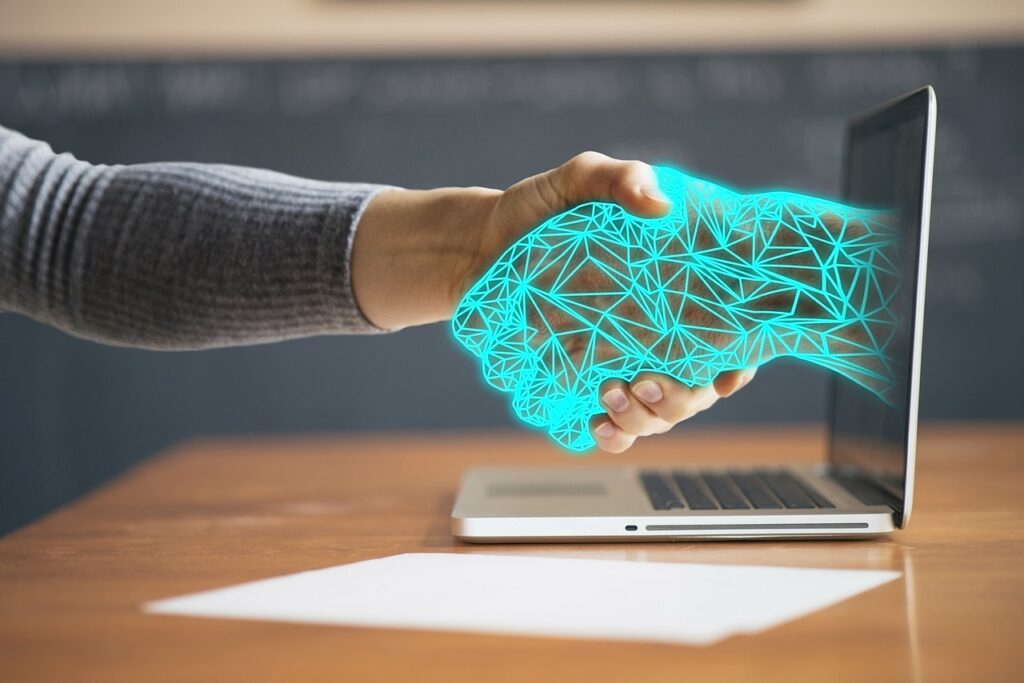Understanding the main goals of cybersecurity is essential for protecting our digital assets. “What are the three goals of cybersecurity?“, is the fundamental question that we are going to examine in this article. These goals serve as the guiding principles for businesses and individuals looking to safeguard their data and systems from harmful threats. They also serve to define the essence of cybersecurity.
What are the Three Goals of Cybersecurity? An Introduction
Embracing the Digital World: A Double-Edged Sword
Embracing technology has turned into a double-edged sword in today’s quickly changing digital landscape. While it provides a wealth of advantages and opportunities, it also makes us vulnerable to evolving threats that could jeopardize our security and privacy. This is where cybersecurity enters the picture, acting as a barrier to safeguard us from threats present in the digital landscape.
Rising Threats in the Digital Landscape
The threat posed by cyber threats is only going to increase as we become more technologically dependent and interconnected. Our digital infrastructure has weaknesses that malicious actors, armed with cutting-edge tools and methods, use in an effort to obtain access without authorization, corrupt sensitive data, and interfere with digital activities. To protect our online safety, we must put a major emphasis on cybersecurity measures due to the frequency and sophistication of these threats.
Understanding Cybersecurity
What Is Cybersecurity?
Before delving into the complexities of cybersecurity and answering the question “What are the three goals of cybersecurity?”, it is crucial to comprehend its foundations. A group of practices, instruments, and defences called “cybersecurity” work to stop illegal or hostile activities on digital systems, networks, and data. The protection of information’s accessibility, confidentiality, and integrity in the digital environment is its primary goal.
For a more detailed overview on cybersecurity and how it works, check our previous article “How Cybersecurity Works: Everything You Need to Know“
What are the Three Goals of Cybersecurity?
In order to understand what are the three goals of cybersecurity, we must examine cybersecurity’s three key tenets, confidentiality, integrity, and availability, to comprehend its goals.
Confidentiality

Privacy protection for sensitive data is crucial in the digital era. A serious privacy breach may result in financial loss and reputational damage. Strong access restrictions and encryption methods are used to ensure confidentiality and stop illegal access to sensitive data.
Protecting Sensitive Information: Privacy Issues
In a time when personal information is going digital at an increasing rate, protecting user data is more crucial than ever. In order to prevent the misuse of sensitive information, it is essential to implement cybersecurity measures including data encryption, safe data storage, and strict user authentication procedures.
Implementing robust access controls to prevent unauthorized access
Accessing critical networks and data without authorization can have terrible repercussions. Organizations can dramatically reduce the likelihood of unwanted breaches by establishing strong access controls like multi-factor authentication, role-based restrictions, and intrusion detection systems.
Integrity

Another important objective of cybersecurity is to maintain the truth and reliability of data. Data manipulation or tampering attempts by malicious parties could have serious repercussions for both persons and companies. Implementing numerous strategies and technologies is necessary to preserve data integrity.
Veracity of Data: Establishing Reliability
Throughout its lifecycle, data integrity makes ensuring that the information is accurate, reliable, and comprehensive. Techniques like data validation, checksums, and data hashing are essential for maintaining the accuracy of data and guaranteeing that it has not been altered.
Alleviating Tampering Risks: Techniques for Preservation
To mitigate risks related to data tampering, organizations rely on techniques like digital signatures and blockchain technology. Digital signatures provide a cryptographic mechanism for ensuring the authenticity of digital documents, while blockchain technology secures data integrity through decentralized and immutable ledgers.
Availability

The seamless availability of digital resources and systems is crucial for both individuals and organizations. Denial of service (DoS) attacks and other disruptive events can lead to service interruptions, causing financial losses and reputational damage. Ensuring availability requires planning for redundancy, disaster recovery, and robust network architecture.
The Lifeline of Digital Operations: Maintaining Access
Availability refers to the uninterrupted availability of digital systems and resources. Organizations invest in redundant systems, failover mechanisms, and disaster recovery plans to minimize downtime and ensure continuous access to critical resources.
The Impact of DDoS Attacks: Bolstering Resilience
Distributed denial of service (DDoS) attacks have emerged as a significant threat in recent years, flooding systems with massive traffic to disrupt services. Mitigation techniques, such as traffic filtering and load balancing, help organizations withstand the impact of these attacks and maintain their availability.
Interdependencies and Overlaps
While confidentiality, integrity, and availability are distinct goals of cybersecurity, they are interconnected and overlap in many ways. The synergy between these three pillars is crucial to developing a robust and comprehensive cybersecurity strategy. Understanding where these goals align and diverge allows organizations to craft tailored approaches to protect their digital assets effectively.
Role of Confidentiality in Cybersecurity

Encryption techniques
Encryption transforms data into an incomprehensible format that can only be broken open with the proper encryption key in order to maintain confidentiality. The two primary types of encryption are symmetric and asymmetric. Each has advantages and things to keep in mind.
Understanding Encryption: The Power of Lock and Key
The mechanism of encryption acts as a lock and key to safeguard sensitive data. Data is converted into an incoherent format by the use of sophisticated algorithms in encryption, rendering it unreadable by unauthorized parties.
Selecting the Best Method for Symmetric vs. Asymmetric Encryption
Symmetric encryption ensures speedy processing but necessitates secure key distribution because it uses a single secret key for both encryption and decryption of data. Asymmetric encryption, in contrast, uses two keys—a public key for encryption and a private key for decryption—and provides a secure method for exchanging keys, however the encryption and decryption procedures are comparatively slower.
Protecting Personal Data
Protecting personal information has become a top priority due to the expansion of online services and digital platforms. Organizations need to balance providing users with a good online experience with guaranteeing data security.
Shielding User Data: Exploring Protection Mechanisms
Organizations must adopt comprehensive protection mechanisms to shield user data from unauthorized access or disclosure. This includes robust authentication processes, secure data storage practices, and regular security audits to identify and address vulnerabilities.
Balancing User Comfort and Data Security: Privacy Dilemmas
While ensuring data security is paramount, it is essential to consider the privacy trade-offs that users may face. Striking the right balance between providing a seamless user experience and implementing robust security measures can be challenging but necessary to gain users’ trust.
Emerging Challenges in Confidentiality
As technology advances, new challenges in maintaining confidentiality emerge. Two such challenges are zero-day vulnerabilities and encryption backdoors, which pose significant risks to data security.
Zero-Day Vulnerabilities: Countering Unseen Threats
Zero-day vulnerabilities are flaws in software or systems that are unknown to vendors and can be exploited by attackers. Organizations must adopt proactive measures like vulnerability scanning and security patch management to mitigate the risks associated with these unseen threats.
Encryption Backdoors: Striking the Delicate Balance
Encryption backdoors, which provide regulated access for law enforcement agencies, pose a delicate challenge. While they may aid in criminal investigations, the existence of backdoors can jeopardize overall data security. Striking the right balance between privacy, civil liberties, and law enforcement requirements is an ongoing concern that requires careful consideration.
Role of Integrity in Cybersecurity

Data Authentication Methods
Ensuring data integrity is vital to maintain trust in the digital landscape. Data authentication methods play a crucial role in verifying the integrity of information and detecting any unauthorized alterations.
Verifying Integrity: Introduction to Data Authentication
Data authentication involves verifying the accuracy and consistency of data throughout its lifecycle. Authentication mechanisms, such as checksums and digital signatures, provide validation to ensure that data remains unaltered.
Hash Functions: The Building Blocks of Data Integrity
Hash functions play a vital role in establishing data integrity. These algorithms generate unique hash values based on the input data, creating a digital fingerprint that enables verification of data authenticity and detecting any tampering attempts.
Ensuring Trust in Digital Transactions
Integrity is pivotal in digital transactions, ensuring that information remains unaltered and trustworthy. To facilitate secure digital transactions, various techniques such as digital signatures and blockchain technology have gained prominence.
Digital Signatures: Enabling a Secure Digital Economy
Digital signatures provide a cryptographic mechanism to establish the authenticity and integrity of digital documents, offering a secure way to verify the origin and integrity of the data. They play a crucial role in the digital economy, enabling secure transactions and contracts.
Blockchain Technology: Revolutionizing Data Integrity
Blockchain technology, most commonly associated with cryptocurrencies, offers a decentralized and immutable ledger system. This innovative technology revolutionizes data integrity by maintaining an unchangeable record of transactions, preventing unauthorized alterations and ensuring trust among participants in a network.
Safeguarding Against Malicious Alterations
Malicious alterations to data can result in severe consequences, ranging from financial loss to the compromise of critical systems. Organizations employ various strategies and tools to prevent and detect unauthorized changes.
Preventing Malware Infections: Key Strategies
Malware infections can lead to unauthorized alterations of data. Organizations must implement robust antivirus software, intrusion prevention systems, and security awareness training to prevent malware infections and their potential impact on data integrity.
Detecting Unauthorized Changes: Intrusion Detection Systems
Intrusion detection systems (IDS) help organizations detect unauthorized changes and suspicious activities within their networks. By analysing network traffic and system logs, IDS can identify potential security breaches, enabling timely responses to mitigate data integrity threats.
Role of Availability in Cybersecurity

Redundancy and Disaster Recovery
Ensuring continuous availability of digital systems and resources demands planning for redundancy and establishing robust disaster recovery mechanisms.
Harnessing Redundancy: Ensuring Continuous Availability
Redundancy serves as a crucial element in ensuring the availability of critical resources. By implementing redundant systems, such as servers, networks, and storage, organizations can prevent single points of failure, offering continuous access even in the event of failures.
The Resilience Factor: Planning for Disaster Recovery
Disasters, whether natural or human-made, can cripple digital infrastructure and disrupt services. A well-defined disaster recovery plan, encompassing backup and restoration procedures, enables organizations to recover rapidly and maintain operations during and after a disaster.
Defence Against DDoS Attacks
Denial of service (DDoS) attacks pose a significant threat to the availability of digital resources. Organizations must deploy robust mitigation strategies to shield against massive influxes of malicious traffic.
Denial of Service Attacks Unveiled: Understanding the Threat
DDoS attacks overwhelm systems with a flood of traffic, rendering them inaccessible to legitimate users. Understanding the different types of DDoS attacks and their characteristics is crucial in devising effective countermeasures.
DDoS Mitigation: Shielding Against Massive Traffic Influx
Mitigating DDoS attacks involves a combination of strategies, including traffic filtering, rate limiting, and the deployment of content delivery networks (CDNs). These measures collectively enhance the resilience of digital resources, ensuring their availability in the face of DDoS attacks.
Network Architecture and Scalability
Building a resilient network architecture, coupled with scalable infrastructure, is crucial in maintaining availability and preventing service disruptions.
Building Resilient Networks: Importance of Scalability
Scalability enables organizations to accommodate growing demand and ensure resource availability. By designing network architectures that prioritize scalability, organizations can enhance their ability to handle increased workloads and scale resources as needed.
Virtual Private Networks (VPNs): A Secure Gateway for Connections
Virtual Private Networks (VPNs) provide secure connections across public networks, allowing individuals to access resources privately and securely. Implementing VPNs enhances availability by ensuring secure connectivity, particularly for remote workers or travellers relying on public networks.
Conclusion
This article provided a brief overview on what are the three goals of cybersecurity. In the ever-expanding digital world, cybersecurity is crucial for safeguarding our digital assets. Organizations and individuals may navigate the digital landscape with confidence knowing that their data and resources are well-protected by focusing on what are the three goals of cybersecurity i.e. confidentiality, integrity, and availability.
Frequently Asked Questions (FAQs)
Following are responses to some frequently asked issues about what are the three goals of cybersecurity:
Q. What are the key obstacles to cybersecurity that corporations must overcome?
A. Securing sensitive data, reducing growing cyberthreats, enforcing security policies, and maintaining awareness of new vulnerabilities are just a few of the difficulties organizations confront.
Q. How can people safeguard themselves from online attacks in their day-to-day lives?
A. By using strong, one-of-a-kind passwords, activating two-factor authentication, being wary of phishing scams, keeping software updated, and utilizing trusted security software, people may secure themselves online.
Q. Do international laws or rules exist that pertain to cybersecurity?
A. Yes, a number of international rules and regulations, like the General Data Protection Regulation (GDPR) of the European Union and the Cybersecurity Information Sharing Act (CISA) of the United States, control cybersecurity. These laws seek to safeguard people’s privacy and promote ethical behaviour.
Q. How does the advancement of technology affect cybersecurity’s objectives?
A. New problems and risks arise as technology develops, needing ongoing innovation and adaptation in cybersecurity strategies. This involves addressing the dangers posed by cutting-edge technologies like cloud computing, artificial intelligence, and the Internet of Things (IoT) while respecting the requirements of confidentiality, integrity, and availability.
We hope this article has helped you in answering the question “What are the three goals of cybersecurity”. If you liked the article please do share it with your friends, family and colleagues.




Pingback: How Cybersecurity Works: Everything You Need to Know - Geek's Corner